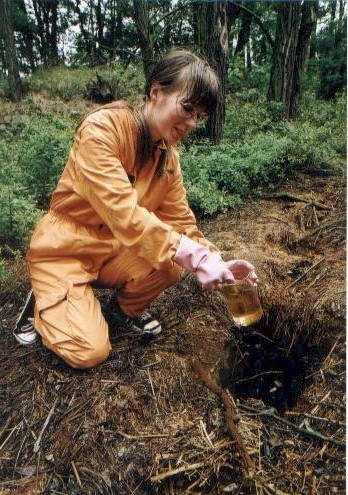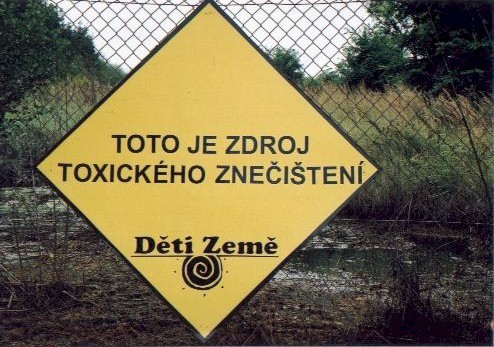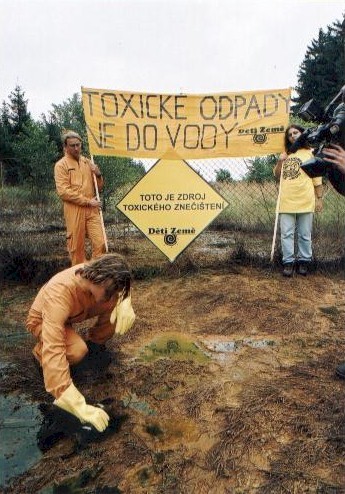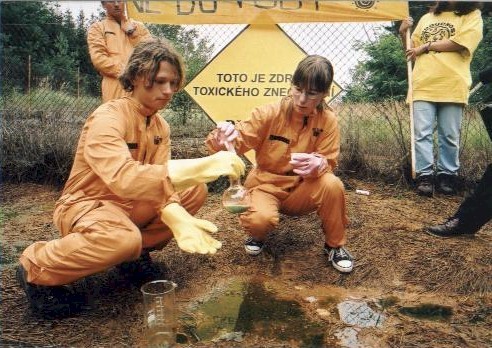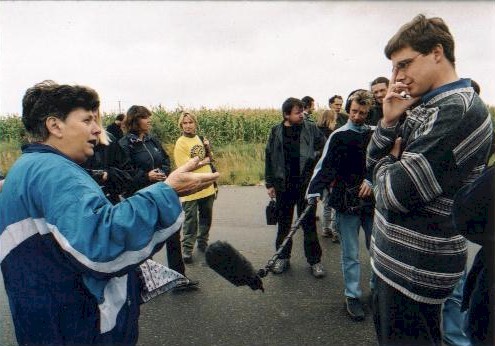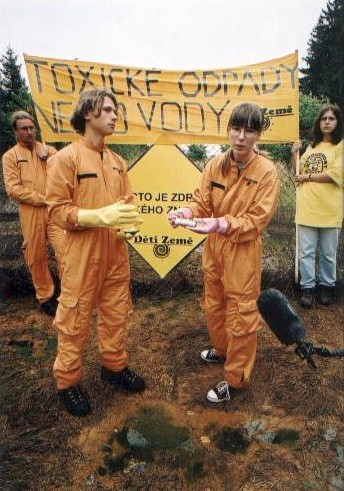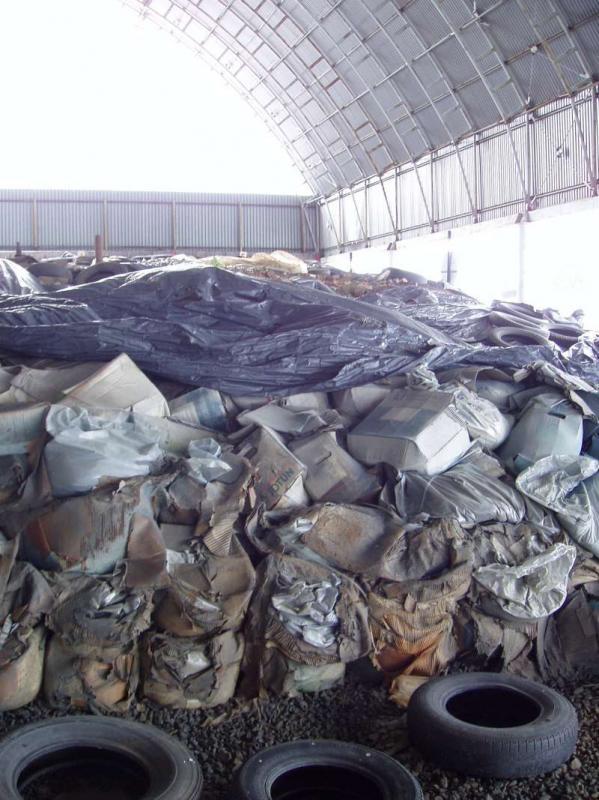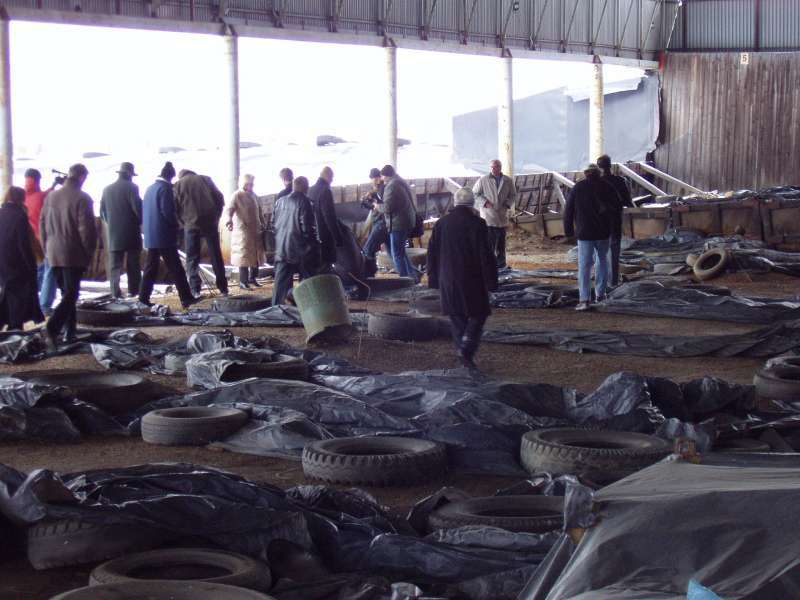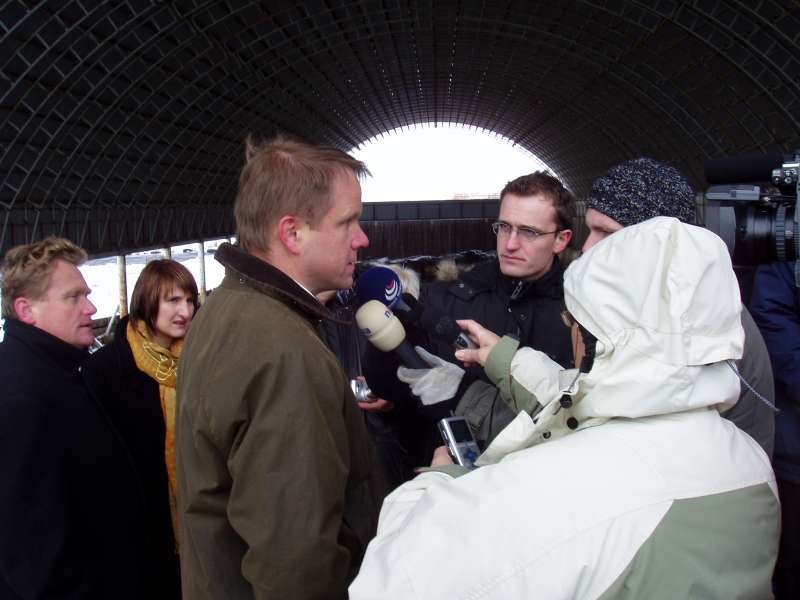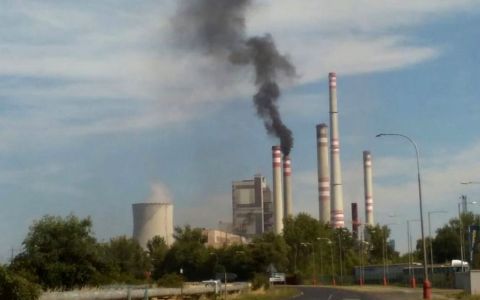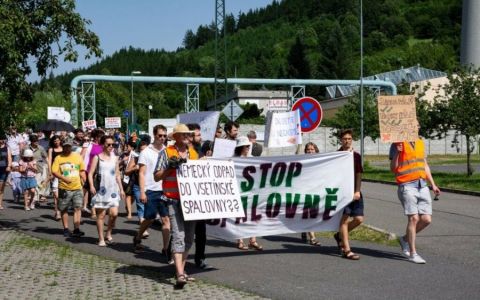One of the biggest environmental disasters in the Vysočina Region was located near a small village Pozďátky for a number of years. A mixture of heavy metals and other poisons with sulphuric acid was leaking into a stream from a damaged hazardous waste landfill. Because the landfill owner became bankrupt, documents were lost, and landfill remediation was very expensive, politicians and officials preferred to overlook the problem. Only after more than ten years the local people succeeded in putting through closing down the landfill and its safe remediation. Nowadays, the site, once dreadful, looks quite ordinarily – a meadow and forest are growing there.
Hardly anybody would expect serious environmental accident in Pozďátky. A picturesque village in a stream valley consists of a few houses only, and it has about fifty inhabitants. Officially, Pozďátky belongs to the municipality Slavičky that is not much bigger - it has further fifty inhabitants. First written record of Pozďátky dates back to 1101, it is connected with founding of a Benedictine monastery in a nearby town Třebíč. For some time, Pozďátky were a holiday resort thanks to the municipality Dobrá Voda where sulphuric spas used to be.
 Photo: Jan Losenický/Arnika
Photo: Jan Losenický/Arnika
Uncontrolled business
Shoe company BOPO Třebíč, joint stock company, adopted a plan to construct a waste landfill in Pozďátky for its own use shortly after political revolution that had ended the communist regime in the Czech Republic. In 1993, the construction was permitted by the Building Authority in Třebíč. Trial operation was started a year later in July, and regular operation of the landfill was approved in the beginning of 1995.
According to the then operator, the company AVE Třebic, part of the International Holding ENVI, the landfill should belong among the most modern ones of its kind in the whole Europe. However, about a year after issuance of the operation approval already, an accident took place in the landfill, due to gross non-compliance with the regulations.
According to the operation approval decision, a thousand tonnes of toxic waste from shoe manufacturing should be deposited on the landfill a year, in safe containers. However, in fact, 137 different kinds of waste, having total weight of 24 thousand tonnes, were brought to Pozďátky between 1994 and 1997. The landfill was not prepared for that at all. The biggest portion of the waste was formed by the so-called acid waste from the company Precheza Přerov. A considerable part of the waste was formed by aggressive ferrous sulphate (green vitriol) that had to be neutralised by the operator before deposition to the landfill, but the operator failed to do that. Due to chemical reactions, sulphuric acid started to be formed in the landfill, having the concentration of 15 %.
This gave rise to an unavoidable disaster. The acid leached heavy metals from the other kinds of waste, and formed a number of toxic compounds. Subsequently, the toxic mixture started to seep into the soil under the landfill, and moved into the valleys of the streams Prasinec and Markovka.
Toxic disaster
 Photo: Děti Země
Photo: Děti Země
Inspections of the Czech Environmental Inspectorate found problems in the landfill, and the operator was given a number of reprimands and conditions. Because the situation was not improved, the Inspectors closed down the landfill for the reasons of improper technical conditions, and threats for its surroundings, in the beginning of 1997. However, the company had economic problems in that time already. In 1998, the company went bankrupt, also because of closing down of the landfill in Pozďátky, where it could not profit from waste deposition any more, and it ceased to operate the landfill.
Subsequently, the former District Authority Třebíč was carrying out emergency measures at its own costs, with the purpose to prevent contamination of surface and underground water. Costs of pumping and transport of landfill water amounted to tens of thousands EUR a year. However, because more fundamental technical solutions were not adopted, it was a question of time only when further accidents would take place. Massive releases of landfill water really took place in the autumn of 2000, and, again, in the spring of 2001.
Landfill attracts businessmen from Italy
In the summer of 2002, a new hope emerged for the village. The Government of the Czech Republic discussed the situation in Pozďátky and decided to buy out the hazardous landfill. The ministers also earmarked funds for the landfill remediation, and estimated its price to be 1.2 to 4 million EUR. However, the state did not succeed in buying out the landfill from the administration of the bankrupt's estate, because an Italian company, ICKM Real Estate, was quicker. It announced a plan for securing and further operation of the landfill, and, thus, it thwarted the Government's plan. However, instead of immediate start of work on ceasing releases of poisonous substances, the company focused on presentation of further operation of the landfill. It was obvious that it regarded deposition of hazardous waste as a way for making easy profits.
Local inhabitants lost their patience, and called on local and regional representatives to take action. They also asked the Arnika Association for assistance. With Arnika's support, local citizens association Pozďátky bez jedů (Pozďátky without poisons) was established immediately afterwards. In view of hazardousness of the situation, Arnika started negotiations with politicians and authorities at all levels of the state administration. In the following years, the accident in Pozďátky became a case closely followed by media.
Arnika's experts took water and soil samples in the neighbourhood of the landfill still in 2002. It became obvious that the contamination level was enormous. Arnika's search revealed that ICKM was a development company owned by Italian businessmen and had no experiences with landfill operation. Thus, it lead to fears that the new owner could only transport further tonnes of poisons onto the site, and, then, disappear in the same way as the owners of the original operator, the company AVE.
Petition against further operation of the landfill in Pozďátky was signed by more than a thousand people in 2003. It turned out that the company ICKM was not able to stop releases of sulphuric acid even within a year. The Regional Authority imposed a fine of 20 thousand EUR on the company, but it did not help. The company blackmailed the authorities by stating that it could not start investments into the landfill securing before receiving permission for deposition of further wastes.
The landfill was left out from the plans
 Photo: NGO Pozďátky without poisons
Photo: NGO Pozďátky without poisons
In 2004, a Waste Management Plan of the Vysočina Region for the next ten years was approved. The representatives came to the agreement that the Region did not need the hazardous waste landfill in Pozďátky anymore, because other facilities existed in the Czech Republic where toxic substances could be deposited safely. Operation of any industrial facility not included in the Regional Plan cannot be permitted.
A further blow for the company ICKM was a new Land Use Plan approved by the municipality Slavičky, by which Pozďátky are governed administratively. In the Plan, the area in the vicinity of the landfill was defined partially as a meadow, and partially as a forest. A land use plan is one of the most effective tools of municipalities in regulation of development on their territory. State authorities must observe it – without approval of the municipality, placing of any structure, thus, also, of a landfill, on its territory, cannot be approved.
However, in spite of this development, the Italian businessmen continued to further their interests. In 2005, the company ICKM established a subsidiary company Logika, and submitted documents for assessment of environmental impacts of the structure. Thus, the EIA process was started. In the process, impacts of industrial plans are assessed. In the case of a hazardous waste landfill, the process is governed directly by the Ministry of Environment. Any citizen may file his/her comments on the submitted documents.
The municipality, local association, Arnika, as well as a number of individuals, opposed the plans of the company Logika. The assessment lasted till 2007. Finally, the Ministry issued a statement approving remediation of the landfill, but forbidding its further expansion and operation. The company Logika announced that it would leave the Vysočina Region. However, local people still did not win. The Italians refused to solve consequences of the accident caused by the previous landfill owner.
Pozďátky were saved by the Government
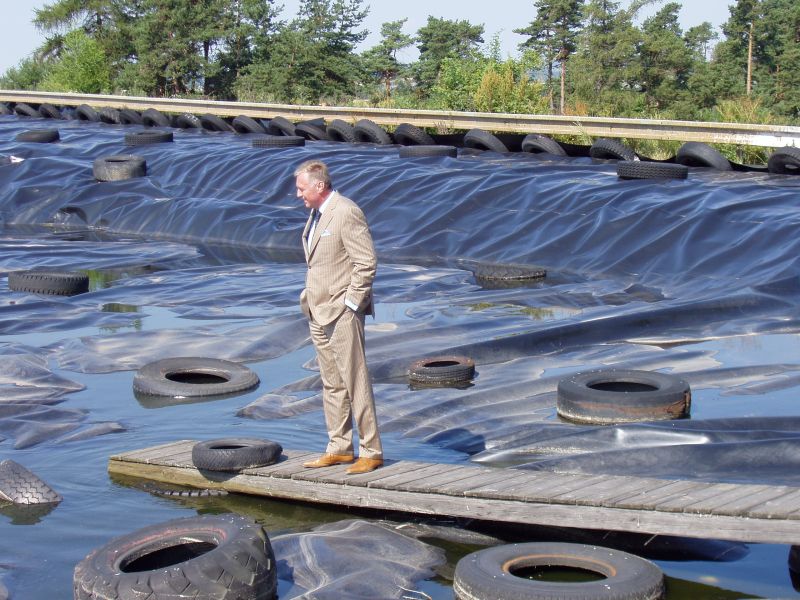
Photo: Arnika/archive
The Arnika Association asked the Government to solve the tragic situation. In the autumn of 2007, the Minister of the Environment visited the Vysočina Region, and promised to help. Already in the summer of 2008, high-ranking people visited Pozďátky itself. Together with the Minister of Environment, the Minister of Industry and Trade and the Prime Minister came to see the toxic lagoon and the structure full of rusty drums. They promised the President of the Region that the Government would solve the situation.
Subsequent complicated negotiations among the Government, the company Logika, and non governmental organisations, lasted two years. The company was trying to get as big indemnity as possible from the state budget. It was in accordance neither with the original purchase price, nor with the actual investments into the landfill. In the beginning of 2009, the state bought out the landfill at last, and handed it over to the state company DIAMO for remediation.
After the necessary analyses, landfill remediation was started in the spring of 2010 finally. Step by step, specialised companies transported 70 thousand tonnes of wastes and contaminated soil away from the site, and pumped out 15 thousand cubic metres of polluted underground water. Although the landfill was in operation for one and a half years only, it was contaminating its neighbourhood for a whole decade. Its remediation lasted further two years – until 2012 – with the costs amounting to 24 million EUR. Although the owner responsible for the landfill accident and endangering of human health was never punished, the case became so infamous that it was mentioned even in a law textbook on environmental crime.
Step by step, the local people narrowed the room for manoeuvre for the businessmen engaged in the waste management field. At first, they attained leaving out the landfill from the Regional Waste Management Plan, and, later, also from the Land Use Plan of the municipality. Thus, the landfill owner would never obtain a permission of operation expansion. Finally, considerable attention paid to the case by the media forced the Government to take action. Without its financial participation, the accident consequences could not be solved.
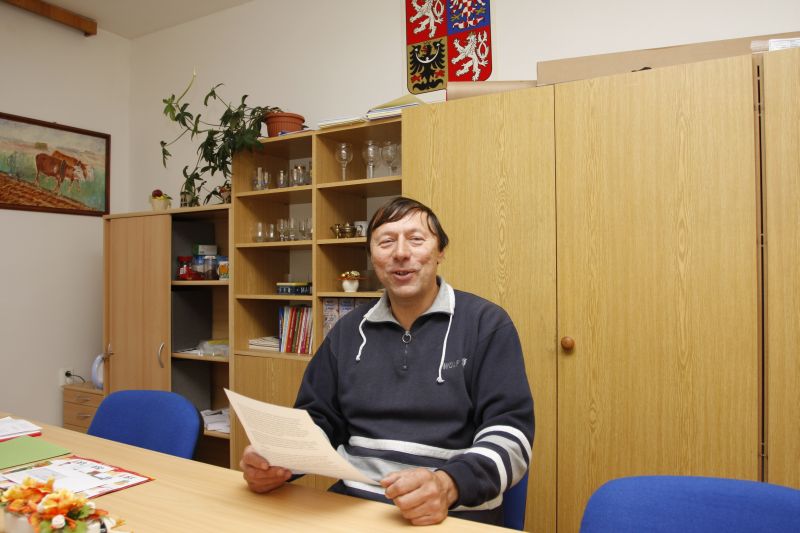
Jiří Válal, Mayor of the municipality Slavičky
„We did not agree with the owner's intention to start operation of the landfill again. We did not want to live in a permanent fear that hazardous substances released from the landfill would threaten our health. Arnika helped the municipality Slavičky with remediation of the hazardous waste landfill in Pozďátky. Especially expert assistance with assessment of intentions of the then landfill owner was invaluable. Nowadays, meadow and forest are in the place of the damaged hazardous waste landfill."
Photos





